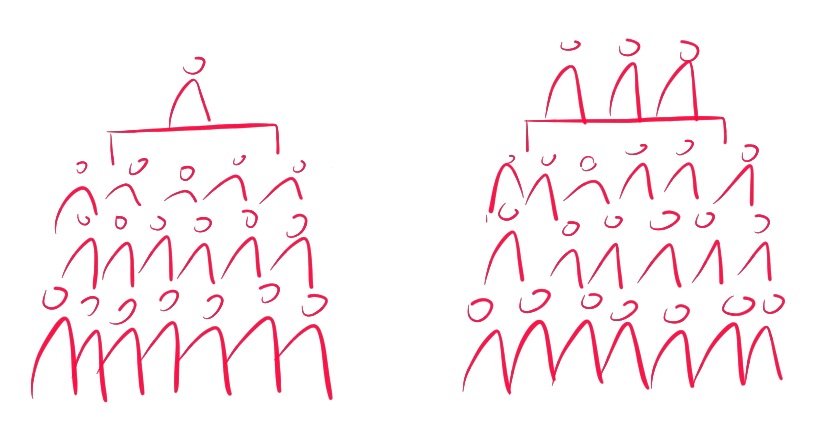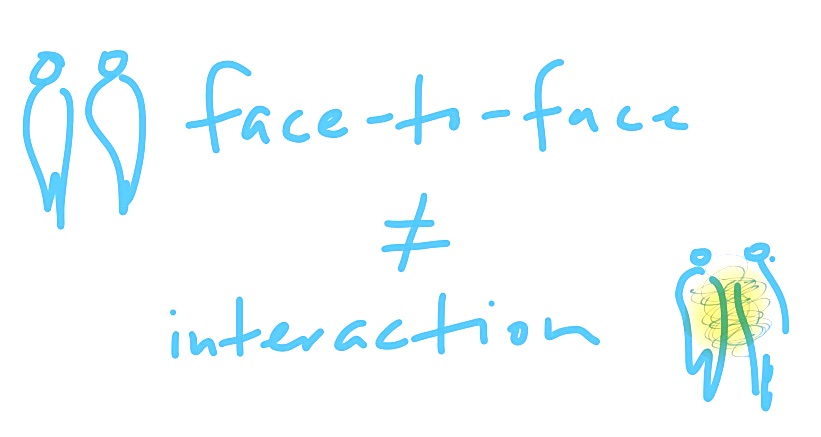Last week I attended a conventional event, with a speaker and an audience. It worked because I got what I was looking for: one-way information from an expert about how to do something.
I also got something I wasn’t looking for: the understanding that it is a big deal, and rare, for people to be in the same room together.
I also got something I wasn’t looking for: the understanding that it is a big deal, and rare, for people to be in the same room together.
The MC, when thanking the speaker, was effusive about how fantastic it was for us to be together, in this room together, authentically. My brain yelled at me: HOLD THE PHONE! DOES HE THINK BEING IN THE SAME ROOM MEANS AUTHENTIC HUMAN INTERACTION?
It got me thinking… do people think that being in the same room, face-to-face, somehow pulls out our authenticity in a way that we do not do via our devices? And what does it mean to be authentic, and does it automatically happen when we are in the same room?
A definition for authentic (adj):
- Being what it is claimed to be; genuine
- Made or done in the traditional or original way
- Based on the facts; accurate or reliable
- Relating to or denoting an emotionally appropriate, significant, purposive, and responsible mode of human life
If something is authentic, it is real, true, or what people say it is (Cambridge Dictionary). When it comes to people, Christopher Collins, in his article about the 5 qualities of an authentic person, defines an authentic person as, “representing one’s true nature or beliefs; true to oneself or to [another] person.” The person is not false or copied, not phony or fake.
I would go on to say this: present.
A person must be present to be authentic.
So yes, the audience and I showed up to get the information we were looking for. There was a little bit of Q & A with the speaker, but otherwise there was no interaction between attendees, the speaker, the MC and the evening’s host. Here’s my proposition: if there is little or no interaction between people, can there be any degree of authenticity? It seems to me that we have to get to know each other in order to know if we are representing our true nature or beliefs, if we are true to oneself or another. If we don’t get to know each other then we don’t get to know our beliefs, let alone if we are each living in accordance with our beliefs. If we don’t interact with each other, we don’t get to know each other. Therefore, if we don’t interact, it is not possible to know if we are authentic. (Perhaps we are, but we don’t know this.)
If there is little or no interaction between people, can there be any degree of authenticity?
So if there are no interactions, there can’t be any degree of authenticity — at least that we know of. Which means that if we are in a room together but do not interact with each other it is at most a shallow degree of authenticity.
I imagine an assumption in the MC’s mind: that since we are in the same room together that we are relationship with each other.
We have to interact to get to know self and other.
Perhaps it is ironic that we get to know more about each other, our thoughts and feelings and perspectives on things in social media than we do in person. On the face of it, social media may be more authentic than a conventional presentation in a room full of people. (Not saying it is; it could be.)
The event and the speaker was authentic in that it was what it said it would be: expert advice. Was it authentic human interaction that allowed everyone an opportunity to represent their true beliefs with integrity, and explore each others’ beliefs? No. We were in the room together but with exception to the speaker, we barely exchanged a couple of sentences with each other. We did not offer to self and others our presence to explore the world and how we make our way through it. Authenticity does not automatically happen.
If we are hungry to simply be in the same room together, are we also hungry for more human interaction that explores ideas and feelings and how we think and feel about those ideas and feelings? I am. It is in this realm that humanity expands itself and grows into new potentials.
If we are hungry to simply be in the same room together, are we also hungry for more human interaction that explores ideas and feelings and how we think and feel about those ideas and feeling? I am.



